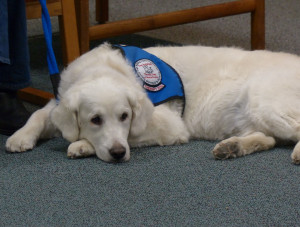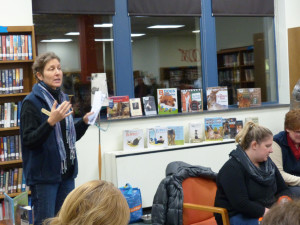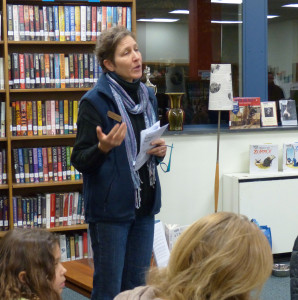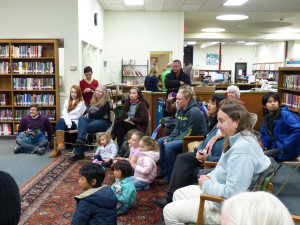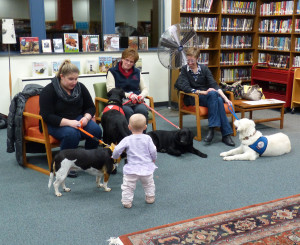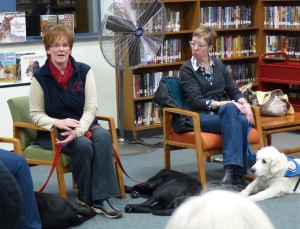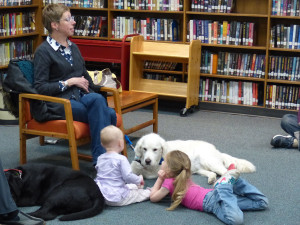Thank you to volunteers from Dog B.O.N.E.S.: Therapy Dogs of Massachusetts for a very successful, informative and moving presentation on Therapy Dogs on the evening of November 13, 2013. Thank-you, too, to the Fox Library, including librarian Laura Lintz, for hosting the event and to the Russell Fund, represented by Karen Dillon, for their support, including a donation to Dog B.O.N.E.S.
The presentation was moderated by Ellen Duranceau, Dog B.O.N.E.S. volunteer and instructor, as well as an A-DOG Board Member. Ellen explained the physical and psychological benefits that therapy dogs can offer to people of all ages. For example, evidence has shown beneficial physiological effects from intereracting with a dog, such as decreases in blood pressure, heart rate, and stress hormones, and increases in feel-good hormones including oxytocin, also known as the “cuddle chemical,” because it is released when bonding with a new baby or romantic partner. Interacting with a dog even for a short time raises spirits, and can reduce feelings of isolation and grief, and has been shown to improve memory and communication in the elderly.
Ellen explained the difference between therapy dogs and service dogs. Service dogs are trained to perform specific functions for an individual with a particular need, such as a guide dog or hearing ear dog, or a dog that assists with post-tramautic stress syndrome, and are allowed by law to travel wherever their people go. Therapy dogs focus not on their handler, but on comforting other individuals in need. Therapy dogs assist a wide range of populations including patients in hospitals, the elderly in nursing homes, Alzheimer’s patients, people awaiting cancer treatment, and children with reading difficulties, emotional or physical disabilities, or autism.
An important part of the event was hearing about the work of the nonprofit, volunteer-run organization Dog B.O.N.E.S. in certifying therapy dog teams, stressing that it is a team – the dog and handler together– that is certified through the organization. Ellen’s own two dogs have worked with her as Dog B.O.N.E.S. therapy dogs, visiting the elderly in Arlington and surrounding towns for 10 years, and only recently did she make the difficult decision to retire them. The work takes a lot of energy and focus and, Ellen explained, it is very important that the human volunteers ensure that the experience is as good for the dogs as it is for the people they are visiting.
Ellen also explained that not every wonderful dog is destined to be a therapy dog. Dogs need to be outgoing, friendly, comfortable with new settings, calm, and well-trained. They cannot be overly aloof, show aggression, jump up, or mouth people. The main focus of the certification process is to ensure that only dogs that will enjoy therapy dog visits and be appropriate for such visits are certified.
After this background about Therapy Dogs, most of the program was devoted to hearing from three therapy dog teams: Arlington resident Brittany DeLorme with her dog Charley; Agnes Shanahan with her dogs Suzie and Rosie, and Marci Goldberg Gorski, also an Arlington resident, A-DOG member and Dog B.O.N.E.S. instructor, and her dog Sophie.
Brittany explained how her background as a children’s librarian introduced her to the great value that therapy dogs can bring to children, especially those having reading difficulties. Reading to a dog, a nonjudgmental and calming audience, has helped many children to improve their reading skills and confidence. Brittany’s experience observing this made her want to get involved, herself in therapy dog work. She rescued her dog Charley, a beagle mix, and quickly realized that working with children was the perfect vocation for Charley. During the presentation, Charley and the other therapy dogs certainly demonstrated their patience and sweet temperaments as several children enthusiastically approached them and wanted to interact throughout the event.
Agnes explained how she had lost her beloved dog and had vowed never to have another one, because the death of her dog had been so painful. Then she agreed to foster a dog from the NEADS service dog program prior to the dog’s further training as a service dog. Agnes fell so in love with this black lab, Suzie, that she was relieved when Suzie later was removed from the NEADS service dog program, due to her nervousness in traffic, making it possible for Agnes to adopt Suzie . They quickly became a therapy dog team. One of their most rewarding activities has been to visit severely disabled children in a residential center. Agnes finds the work deeply satisfying and moving, particularly when Suzie brings smiles to the children’s faces. Suzie also helps out as a reading partner for a public library program. More recently, Agnes adopted Rosie, another NEADS “furloughed” black lab, who is preparing for final therapy dog certification.
Marci described how she rescued her dog, Sophie, a white-blonde golden retriever, when living in the Netherlands. Like the others, she quickly realized that Sophie’s gentle nature, and interest in meeting new people, would make her an ideal therapy dog. Sophie and Marci have been visiting a vocational program for young adults in Arlington for a number of years, and had become quite attached to the people there, though they have had to seek other sites to visit because Sophie can no longer manage the stairs. They also visit local colleges during exam-week stress relief events, and help at the annual “critter day” at the Children’s Museum in Boston. Marci emphasized a point also made by Agnes, that the staff at hospitals and nursing homes, working in an emotionally stressful environment, often derive as much benefit from the visiting therapy dogs as do their patients.
Ellen, Brittany, Agnes and Marci addressed many wide-ranging and thoughtful audience questions from the sizeable group gathered, and gave attendees ample opportunity to interact with their dogs. It was clear from hearing the volunteers speak about their passion for visiting with their dogs, and their dogs’ excitement about their “jobs,” that the simple process of having people interact with dogs offers benefits to everyone involved, not just those the dogs visit, but also the dogs’ owners and the dogs themselves.
For more information about Dog BONES and becoming a therapy dog team, see www.therapydog.info.

